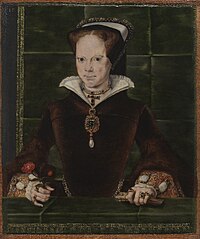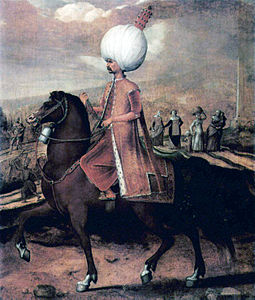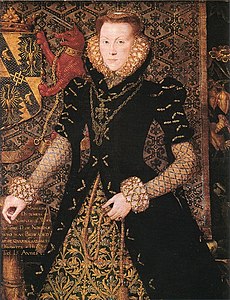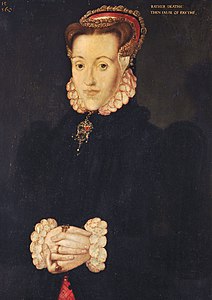Hans Eworth

Hans Eworth (or Ewouts; c. 1520–1574) was a Flemish painter active in England in the mid-16th century. Along with other exiled Flemings, he made a career in Tudor London, painting allegorical images as well as portraits of the gentry and nobility.[1] About 40 paintings are now attributed to Eworth,[2] among them portraits of Mary I and Elizabeth I. Eworth also executed decorative commissions for Elizabeth's Office of the Revels in the early 1570s.
Career
[edit]
Nothing is known of Eworth's early life or training. As ″Jan Euworts″,[3] he is recorded as a freeman of the artists' Guild of St Luke in Antwerp in 1540. A ″Jan and Nicholas Ewouts, painter and mercer″ were expelled from Antwerp for heresy in 1544 and scholars generally accept that this Jan is the same individual.[4] By 1545 Eworth was resident in London, where he is well recorded (under a wide variety of spellings) from 1549.[1]
Eworth's earliest surviving works also date from 1549 to 1550. These include the allegorical portrait of Sir John Luttrell with the goddess Pax, commemorating Luttrell's military exploits and the Treaty of Boulogne (24 March 1550) which finally brought peace between England, Scotland, and France after the long wars known as the Rough Wooing.[5] The original – signed with the "HE" monogram Eworth consistently used[6] — was donated to the Courtauld Institute of Art by Lord Lee of Farnham in 1932.[7] The painting was in "badly damaged" condition when it was donated to the institute, although it has subsequently been conserved and restored.[8]
Although there is no direct evidence that Eworth's most important patron was the Catholic queen Mary I, most scholars now accept this to be the case.[9] All his known portraits of Mary I appear to be variants of a portrait in the National Portrait Gallery, London (above) which is signed 'HE' and dated 1554 at the top left.[2] A second portrait, now in the Society of Antiquaries collection, is also signed and dated 1554. Two other portraits show Mary I in later fashions and are thought to have been painted between 1555 and Mary's death in 1558. Another is in the collection of Trinity College, Cambridge.[10] However, after Mary I's death and the change of the political and religious atmosphere with the accession of Elizabeth I, Eworth in 1560 painted the Protestant Martyr Anne Askew, burned at the stake on charges of heresy.
Over the next decade, Eworth continued to paint portraits of the aristocracy, including paired portraits of the Duke of Norfolk and his second wife and of the Earl and Countess of Moray.[11]
Despite the frequent appearance of a characteristic "HE" monogram, the attribution of works to Eworth—and the identification of his sitters—remains in flux. A well-known painting identified by George Vertue in 1727 as Lady Frances Brandon and her second husband Adrian Stokes has now been correctly identified as Mary Nevill or Neville, Baroness Dacre and her son Gregory Fiennes, 10th Baron Dacre.[12] The allegorical painting Elizabeth I and the Three Goddesses (1569), with its slightly different "HE" monogram, has been variously attributed by Sir Roy Strong as cautiously to "The Monogrammist HE" in 1969[11] and more confidently to Joris Hoefnagel in 1987;[13] it is now accepted as the work of Eworth.[14] Eworth's last known works date from 1570 to 1573.[15]
Like many other artists of the Tudor court, Eworth was also engaged in decorative work; he was involved in the set design for a masque given by Elizabeth I in honor of the French Ambassador in 1572. Payment records show that Eworth was designing for the Office of the Revels as late as 1573, and he is believed to have died in 1574.[1][4]
Gallery
[edit]-
Suleiman the Magnificent on horseback
-
Henry FitzAlan, 19th Earl of Arundel as a Roman Emperor, 1550
-
Portrait of an Unknown Lady, formerly called Mary I (possibly Jane Dormer or Lady Jane Grey), c. 1550–55
-
Mary I, 1554, oil on panel
-
Mary I, c. 1555–58, oil on panel
-
Mary Fiennes, Baroness Dacre, c. 1555–1558, oil on panel
-
Mary Fiennes and her son Gregory Fiennes, 1559
-
Henry Stuart, Lord Darnley, and Charles Stuart, 1563
-
Elizabeth I and the Three Goddesses, 1569
-
Elizabeth I c. 1570
-
Protestant Martyr Anne Askew, 1560
Notes
[edit]- ^ a b c Concise Grove Dictionary of Art, "Hans Eworth".
- ^ a b Cooper, "Hans Eworth: Four case studies of painting methods and techniques"
- ^ Hearn has "Eeuwowts", p. 63
- ^ a b Hearn pp. 63–64
- ^ The complex allusions in this painting were first decoded by Dame Frances Yates in "The Allegorical Portraits of Sir John Luttrell", Essays in the History of Art Presented to Rudolf Wittkower (London, 1967), pp. 149–60, cited and summarized in Hearn, p. 65 and Cooper, p. 22
- ^ Cooper, Tarnya (2012). Citizen Portrait. Yale University Press. p. 42.
- ^ Ernst Vegelin van Claerbergen, The Portrait of Sir John Luttrell: A Tudor Mystery, London: Jistlynn Ltd., 2000, 1.
- ^ van Claerbergen, The Portrait, 1-3. A well-preserved copy, which was made by George Luttrell in 1591 and which now hangs at Dunster Castle, was the source of much of Dame Yates' research.
- ^ Hearn et al suggest this was the case due to the high rank of the Queen and the limited access that he would have otherwise had with her were she not to be his patroness.
- ^ "Trinity College, University of Cambridge". BBC Your Paintings. Archived from the original on 19 November 2014.
- ^ a b Strong 1969
- ^ Based on the ages of sitters and a ring worn by Mary Neville; see Hearn, p. 68; see also Elizabeth Honig, "In Memory: Lady Dacre and Pairing by Hans Eworth" in Renaissance Bodies: The Human Figure in English Culture c. 1540–1660.
- ^ Strong 1987, p. 42
- ^ The Royal Collection, which owns the picture, attributes it to Eworth
- ^ A portrait of Elizabeth I c. 1570, attributed to Eworth, sold at auction in 1996 and is now in the Denver Art Gallery's Berger Collection. The Wallace Collection has 'A Portrait of a Gentleman of the Selwyn Family' dated 1572 and likewise attributed to Eworth.
References
[edit]- van Claerbergen, Ernst Vegelin. The Portrait of Sir John Luttrell: A Tudor Mystery, London: Jistlynn Ltd., 2000.
- Cooper, Tanya, A Guide to Tudor & Jacobean Portraits, National Portrait Gallery, London, 2008, ISBN 978-1-85514-393-7
- Cooper, Tanya. "Hans Eworth: Four case studies of painting methods and techniques". Making Art in Tudor Britain. Retrieved 14 November 2008.
- "Hans Eworth." In The Concise Grove Dictionary of Art. Oxford University Press, Inc., 2002. Answers.com 14 Nov. 2008. [1]
- Cust, Lionel, 'The Painter HE', Second Annual Volume of the Walpole Society 1912-1913, Oxford (1913) & London (1969), 1-44.
- Hearn, Karen, ed. Dynasties: Painting in Tudor and Jacobean England 1530-1630. New York: Rizzoli, 1995. ISBN 0-8478-1940-X
- Honig, Elizabeth, "In Memory: Lady Dacre and Pairing by Hans Eworth" in Renaissance Bodies: The Human Figure in English Culture c. 1540–1660 edited by Lucy Gent and Nigel Llewellyn, Reaktion Books, 1990, ISBN 0-948462-08-6
- Strong, Roy,The English Icon: Elizabethan and Jacobean Portraiture, 1969, Routledge & Kegan Paul, London (Strong 1969)
- Strong, Roy, Nicholas Hilliard, 1975, Michael Joseph Ltd, London, ISBN 0-7181-1301-2 (Strong 1975)
- Waterhouse, Ellis, Painting in Britain, 1530–1790, 4th Edn, 1978, Penguin Books (now Yale History of Art series)
External links
[edit]- HansEworth.com
- 29 artworks by or after Hans Eworth at the Art UK site














